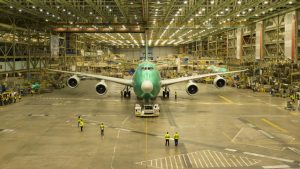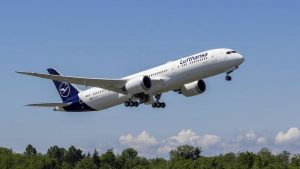After 1,574th aircraft, Boeing calls time on 747
December 12, 2022407 views0 comments
By Business AM
- Charlotte Seet, Simpleflying.com
After more than five decades, aircraft manufacturer Boeing hit a bitter-sweet milestone on the evening of December 6th as the last Boeing 747 rolled out of its production line at Paine Field in Everett, Washington. The 1574th Boeing 747 will go through test flights before being delivered to Atlas Air early next January.
The jumbo aircraft bears the Manufacturer Serial Number 67150 and will eventually be registered as N863GT. And once it is delivered, it will mark nearly 52 years since the first Boeing 747 was delivered to the now-defunct Pan Am in January 1970.
The Queen of the Skies: A historical legacy
Having been in production since September 1968, the Boeing 747, often dubbed the ‘Jumbo Jet’ or the ‘Queen of the Skies,’ was designed by engineer Joe Sutter. With the ability to carry up to 524 passengers, the semi-double-deck quad-engined aircraft was twice the size of the Boeing 707, a smaller aircraft popularly used by several airlines during the 1960s.
The first test took off in February 1969, with the first delivery in the following year to the now-defunct Pan Am. Though the airline may no longer exist, Pan Am was a powerhouse airline back in the day, so the idea of flying in the Boeing 747 corresponded with travelling to exotic and exciting places. Eventually, the Boeing 747 became the world’s first mass-produced widebody civil aviation aircraft.
By 1993, Boeing had accumulated orders for more than 1,000 Boeing 747s, and by June 2014, more than 1,500 of the aircraft had been produced, with another 38 still on order. As the decades passed, the Boeing 747 also evolved with different iterations, such as Air Force One, the 747-8, and the freighter versions. It also held the record for the world’s highest passenger capacity aircraft for 37 years.
But despite how iconic the aircraft was and still is, it was inevitable that it would slowly retire as the demand for twin-engined aircraft rose due to better economies. Once the pandemic hit in 2020, Boeing made the difficult decision to stop the production of all 747 series aircraft in 2022, and the roll-out of N863GT officially marks the end of this era.
Kim Smith, vice president and general manager of Boeing 747 and 767 Programmes, highlighted the reality:
“It’s a very surreal time, obviously. For the first time in over 50 years, we will no longer have a 747 in this facility.”
Plenty of years left for active service
While the end of production for the Boeing 747 aircraft is definite, it doesn’t mean that the aircraft completely disappears from the skies, as there are still commercial airlines actively flying them today. Asiana Airlines operates just one Boeing 747-400 for passenger-carrying flights and features eight premium business class seats in the nose. The aircraft currently operates flights between Seoul and Changchun.
Another chance of catching the jumbo jet in the Asia-Pacific would be from Korean Air, as the airline operates the Boeing 747-8 aircraft on its Seoul-Honululu, Seoul-Los Angeles, Seoul-Atlanta, and Seoul-Tokyo routes. And as the largest operator of the passenger-configured Boeing 747, Lufthansa’s fleet is certainly active and flying to several destinations, such as Singapore, Tokyo-Haneda, Washington, and Shanghai, to name a few.
Then finally, there’s Mahan Air’s sole Boeig 747-400, which has been actively flying from Tehran to Istanbul and Moscow lately. While it is uncnertain how long these passenger-configured jumbo jets will continue flying, it will likely be at least another few more years. There are also active freighter versions from several cargo carriers – such as Atlas Air, UPS, and Cathay Pacific Cargo, where the Boeing 747s are likely to operate for several more years as well.
Bottom line
Although the Boeing 747 will never be produced, the aircraft certainly left behind quite a prosperous legacy that spanned over five decades. It is a definite shame to see the end of such an iconic era, but an end for Boeing in this chapter will unravel the beginning of other, possibly iconic chapters, such as the Boeing 777X. Whether or not Boeing will ever produce another classical aircraft remains to be seen with the future of twin-engined jets, but it is not impossible.


